
Image 4A
Image 4B
Image 4
Image 5
Image 8
Image 6
Image 7
9
8
USER MANUAL
KEGERATOR
I.
Place the CO
2
cylinder onto the bracket at
the back of the kegerator. Thread the velcro
belt supplied through the holes at each end -
ensure it is tightly in place.
J.
Unscrew the black cap on the back of the
Kegerator and remove the small bung (see
image 5). *Note if you are using the The
Kegerator as a fridge only do not remove the
black bung.
K.
Feed the black gas line through the white hole
from the inside of the Kegerator and screw
the black cap back on (see image 6). Connect
the gas line to the regulator provided to the
regulator fitting as shown in image 7. Push
the line in well and pull on it to make sure it
is secure in the fitting.
L.
Turn on the CO
2
bottle and ensure there are
no leaks. Set the regulator at the pressure
you require. An average pressure would be
about 1.1 bar (110 kPA) or 16 psi, but this
does depend on the beverage type and the
temperature you are serving at. If you are
using a D-Style keg (Sanke keg) bought
from a brewery in your kegerator, follow their
guidelines for pressure and temperature. If
you have brewed a beverage in a WilliamsWarn
BrewKeg25
TM
or a BrewKeg10
TM
and are
serving it from the kegerator, or if you have
brewed in a BrewMaster and have transferred
the beverage into a Cornelius keg for
dispense, we’d recommend a temperature
between 1-4°C and a pressure range of about
1.1 bar (110 kPA or 16 psi). The higher
the pressure the higher the carbonation,
and the colder the beverage the higher the
carbonation, so if you find your beverage is
too carbonated, you can brew and dispense on
the lower side of the range, to suit your taste.
Conversely, if you find not enough bubbles are
in your beverage, increase your brewing and
dispensing pressures to the higher end of the
range. The BrewKeg10
TM
is a small vessel so
you may find that a brewing and dispensing
pressure nearer the 1 bar level (100kPA, 14.5
psi) is preferable to avoid over-carbonating
the beverage. An over-carbonated beverage
will foam more when poured and taste more
effervescent. Please note that when a beer
cools, the CO
2
dissolves better, and the
pressure drops a little bit, so a WilliamsWarn
vessel’s brewing pressure is usually set about
0.25 bar (250 kPA) higher than the dispense
pressure, to account for the drop once it’s
cooled after fermentation.
M.
Plug in and set temperature to the desired
dispense temperature. The table below shows
typical serving temperatures for various
beverages. In general, ales are traditionally
served warmer than lagers, but you can of
course choose whatever temperature you
prefer to drink a beverage at. A temperature
set around 1-4°C is a good range to start at
for a first time user.
The Kegerator also comes with a fan and
tubing that can be inserted up into the font in
order to cool the font down. Just push the fan
button on the control panel to activate the fan.
N.
The Stainless steel connections connect to the
Keg fittings by pulling back on the collar (See
image 8) and pushing onto the fitting onto the
BrewKeg™ or Cornelius Kegs.
O.
Then place the font guard rail on top of the
kegerator and place the drip tray in front of
the font.
BEVERAGE
TYPICAL SERVING
TEMPERATURE
Lagers
1 - 7°C / 34 - 45°F
Ales in New World Countries
1 - 8°C / 34 - 46°F
Wheat Beers
6 - 10°C / 43 - 50°F
British and Belgian Ales
7 - 13°C / 45 -55°F
Cider and Mead
5 - 16°C / 41 - 61°F
Strong Dark Ales and
Barley Wines
10 - 15°C / 41 - 61°F
Содержание kegerator
Страница 8: ......


























